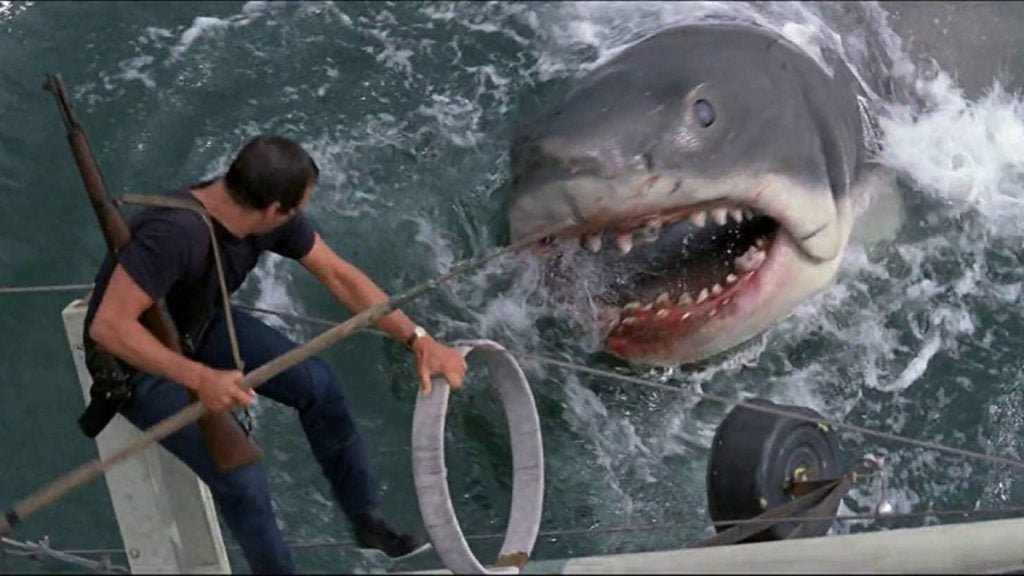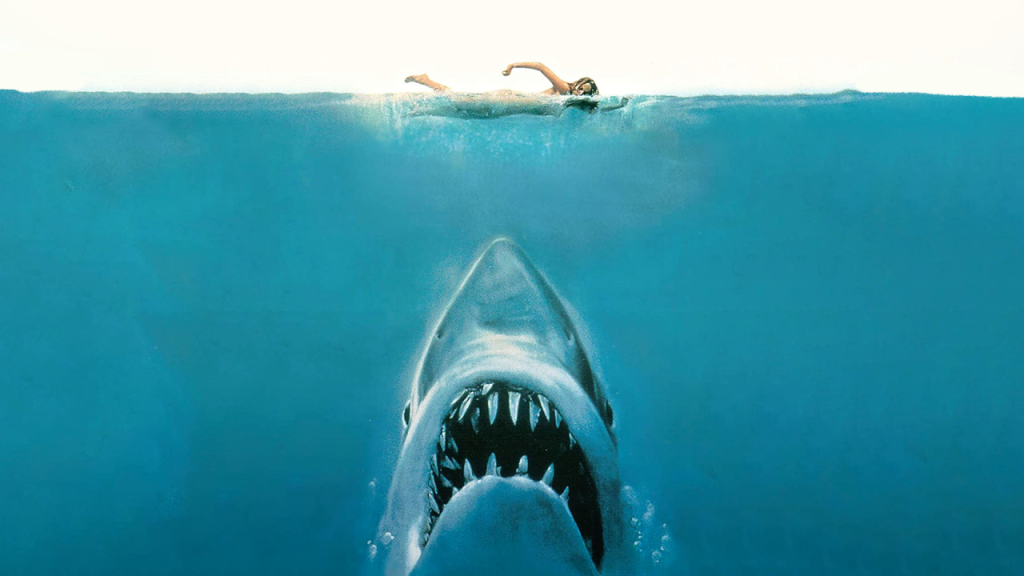“You’re gonna need a bigger boat” – Chief Brody (Roy Scheider)
On June 20, 1975, a mechanical shark named Bruce and a haunting two-note score unleashed terror on audiences worldwide, forever changing cinema. Jaws, directed by a then-28-year-old Steven Spielberg, celebrates its 50th anniversary , marking half a century as a cultural juggernaut and the blueprint for the modern blockbuster. This article honors the film’s monumental accolades, its transformative impact on the thriller and horror genres, and its enduring influence on filmmakers and audiences alike.
A Triumph of Accolades
Jaws was a critical and commercial titan upon release, earning over $470 million worldwide against a $9 million budget, making it the highest-grossing film of its time until Star Wars surpassed it in 1977. Its critical acclaim matched its box-office dominance, securing three Academy Awards in 1976: Best Film Editing (Verna Fields), Best Original Score (John Williams), and Best Sound. The film was also nominated for Best Picture, a rare feat for a genre film, though it lost to One Flew Over the Cuckoo’s Nest.
Beyond the Oscars, Jaws earned a Golden Globe for John Williams’ iconic score and was later inducted into the National Film Registry by the Library of Congress in 2001 for its cultural, historical, and aesthetic significance. The American Film Institute ranked it 56th on its “100 Years…100 Movies” list and second on its “100 Thrills” list, cementing its status as a cinematic touchstone. These accolades reflect not just the film’s technical brilliance but its ability to resonate across generations.

Redefining the Blockbuster and the Thriller Genre
Jaws is widely credited with inventing the summer blockbuster. Before its release, summer was a slow season for theaters, but Universal’s aggressive marketing—national TV ads, a wide release on 409 screens, and tie-in merchandise—set a new standard for Hollywood. The film’s success proved that high-concept, mass-appeal movies could dominate the box office, paving the way for franchises like Star Wars, Jurassic Park, and the Marvel Cinematic Universe.
Within the thriller and horror genres, Jaws redefined how suspense was crafted. Spielberg’s decision to show the shark sparingly, due to mechanical failures during production, heightened tension and forced audiences to rely on their imaginations—a technique now synonymous with effective horror. John Williams’ minimalist, pulse-pounding score became a character in itself, its duh-dun motif evoking primal dread. This less-is-more approach influenced countless filmmakers, from Ridley Scott in Alien (1979), which used sparse visuals to build terror, to John Carpenter’s Halloween (1978), where a simple piano riff amplified suspense.
The film’s character-driven storytelling also set it apart. The trio of Chief Brody (Roy Scheider), oceanographer Hooper (Richard Dreyfuss), and shark hunter Quint (Robert Shaw) grounded the horror in human conflict and camaraderie. Their dynamic inspired ensemble-driven thrillers like The Thing (1982) and Predator (1987), where interpersonal tension amplifies external threats.
Influence on the Creature Feature and Beyond
Jaws birthed the modern creature feature, spawning a wave of “nature strikes back” films. The late 1970s and 1980s saw a flood of imitators, from Orca (1977) and Piranha (1978) to Alligator (1980), each attempting to replicate Jaws’ formula of a predatory beast terrorizing humans. While few matched its artistry, these films cemented the subgenre’s popularity. Even today, low-budget shark thrillers like The Shallows (2016) and 47 Meters Down (2017) owe their existence to Jaws, as does the tongue-in-cheek absurdity of Sharknado (2013).
Beyond creature features, Jaws influenced aquatic horror and survival thrillers. Films like Open Water (2003) and The Reef (2010) echo its primal fear of the ocean, while Crawl (2019) channels its blend of natural disaster and predatory menace. Spielberg himself revisited the template with Jurassic Park (1993), swapping sharks for dinosaurs but retaining the awe, terror, and human drama that made Jaws timeless.
The film’s impact extends to technical filmmaking. Spielberg’s use of point-of-view shots, particularly the shark’s underwater perspective, became a staple of horror, seen in everything from Friday the 13th (1980) to The Blair Witch Project (1999). His innovative use of the dolly zoom to convey Brody’s shock on the beach inspired directors like Quentin Tarantino and Edgar Wright to experiment with visual storytelling.
A Lasting Legacy
Fifty years later, Jaws remains a masterclass in suspense, storytelling, and innovation. Its influence is evident not just in cinema but in pop culture—theme park rides, memes, and even shark conservation efforts spurred by the film’s demonization of great whites. While it inspired countless imitators, few have matched its balance of terror and humanity.
As we celebrate this milestone, Jaws reminds us why we fear the ocean and why we keep diving back in. It’s more than a movie; it’s a primal scream, a technical triumph, and a testament to Spielberg’s genius. Here’s to 50 years of keeping us out of the water—and glued to our screens.
Note: All box-office figures and award details are sourced from historical records and industry databases like Box Office Mojo and the Academy Awards archives.


DC Fanboy! Superman is the greatest comic book character of all time. Favorite movies are Man of Steel, Goonies, Back To the Future




![‘Jay Kelly’ Review – Noah Baumbach Makes A Case For The Magic Of Movie Stardom [NYFF 2025] ‘Jay Kelly’ Review – Noah Baumbach Makes A Case For The Magic Of Movie Stardom [NYFF 2025]](https://cdn.geekvibesnation.com/wp-media-folder-geek-vibes-nation/wp-content/uploads/2025/11/Jay-Kelly-JKELLY_20240523_15320_C2_R-300x180.jpg)

